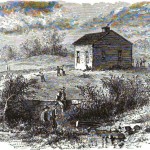In 1900, T.C. Steele’s landscape The Bloom of the Grape , painted on-site in Indiana’s Muscatatuck Valley just a few years earlier, won an honorable mention at the Paris Universal Exposition. The painters who were putting Indiana on the map at the turn of the twentieth century were members of a transitional generation. Born at a time when the only artists in evidence were journeyman equally adept at painting a picture or a barn, many of those who would become associated with “the Hoosier School” sought out the expanded options for artistic training in Europe.
Meanwhile, and as these artists began returning, the life of the visual arts in Indiana was becoming increasingly sophisticated. The state’s first art academy, The Indiana School of Art, was founded in 1877; with similar institutions opening in Indianapolis in 1885 and in Muncie in 1887. A significant regional community of artists, including John Elwood Bundy and Maude Kaufman Eggemeyer, coalesced in Richmond, Indiana, where the Richmond Museum of Art was founded in 1898.
Steele, Forsyth, Adams and the other “Hoosier painters” were capturing the scenery in such southeastern Indiana pockets as Brookeville and Vernon, until the opening of a rail station in Helmsburg sparked interest in the nearby hamlet of Nashville, which would eventually gain renown as “The Art Colony of the Midwest.”






















